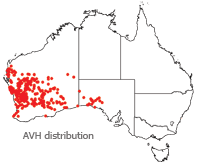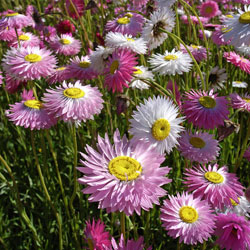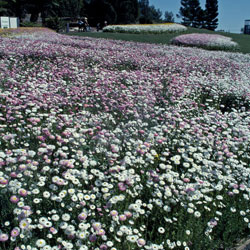Rhodanthe chlorocephala
Pink and White Everlasting, Rosy Sunray, Pink Paper-daisy
Rhodanthe chlorocephala (Turcz.) Paul G.Wilson
Rhodanthe chlorocephala is a native Australian daisy belonging to the family Asteraceae. It is widely grown due to its attractive flowers and foliage, and because it’s hardy, adaptable and provides a good, fast ground cover. The flowers are long-lived and dry well.
 Rhodanthe chlorocephala subspecies rosea is the most widely grown subspecies and is commonly known as “Pink and White Everlasting”, “Rosy Sunray”, “Pink Paper-daisy” and “Rosy Everlasting”. It grows naturally in the south of Western Australia extending into South Australia.
Rhodanthe chlorocephala subspecies rosea is the most widely grown subspecies and is commonly known as “Pink and White Everlasting”, “Rosy Sunray”, “Pink Paper-daisy” and “Rosy Everlasting”. It grows naturally in the south of Western Australia extending into South Australia.
Rhodanthe chlorocephala subsp. rosea is an erect annual herb 20-60cm high with clumps of glabrous (hairless) grey-green stems and leaves 1-6cm in length. It has a large single flowering head at the tip of each stem. Flower heads grow to 6cm diameter, gradually decreasing as the flowering season progresses. The color of the bracts varies from deep pink (almost red) through pale pink to pure white, with a yellow or black centre. Stems branch early in the season. You can encourage this habit (to create more blossoms) by pinching out the growing tips.
Rhodanthe chlorocephala subsp. rosea is adaptable and ephemeral, springing up whenever conditions are right e.g. during warm, sunny weeks anytime of the year. It prefers full sun to dappled shade and grows well in open woodland. Grown in full shade it tends to be long and spindly. It thrives in well-drained sandy soils and tends to be smaller when grown in heavy, clay soils.
It generally flowers from August to November in the wild but with sufficient water and warmth it will flower at other times. It flowers 10 to 12 weeks after germination and the flowers last a good two weeks. The flowering period lasts 4 to 10 weeks. Fruit appear approximately 4 weeks after flowering.
Rhodanthe chlorocephala subsp. rosea responds well to any general fertilizer and regular watering - which may be once a week to once a day depending on soil type and daily temperature. You can cut plants back and they will flower again.
Seeds germinate in 7 to 21 days and can be sown in autumn directly on the soil surface or lightly buried. There is almost 100% germination rate. Seeds can also be grown in trays to approximately 2 cm high (4 to 5 weeks) then planted out. Seeds are collected from mature flower heads and prepared for planting by placing in a paper bag and keeping in a warm environment. Rhodanthe chlorocephala will also grow from cuttings.
Although the plants are adaptable and hardy, there are a few factors that limit their growth. Heavy, clay soils lead to smaller plants and a lack of sun makes them weak and spindly. Seedlings can be damaged by frosts (although local populations in the Australian National Botanic Gardens are becoming frost resistant). Plants face a number a predators including Rutherglen bugs, kangaroos, rabbits, slugs, snails and aphids.
Text by Diana Richards (2008 Botanical Intern)
Name Meaning: Rhodanthe chlorocephalaRhodanthe - from Greek Rhodon meaning “rose” and anthos meaning “a flower” (this is presumed to refer to the color of some Rhodanthe species) chlorocephala – from Greek chloro meaning “green” and cephale meaning “a head” (this refers to the green outer bracts on the flower heads of the type specimen). |
References
Association of Societies for Growing Australian Plants (2007) Rhodanthe chlorocephala. Available at http://asgap.org.au/r-chl.html [Accessed February 2008]
Australia ’s Virtual Herbarium (AVH) (2008). Council of Heads of Australian Herbaria (CHAH). Available at http://www.cpbr.gov.au/chah/avh/index.html
Botanic Gardens Trust (undated) Rhodanthe spp. Available at http://www.rbgsyd.nsw.gov.au/welcome_to_bgt/annan/the_garden/blooming_calendar/rhodanthe_chlorocephala [Accessed February 2008]
Coleman, H. (1997) Rhodanthe chlorocephala subsp. rosea (Hook.) Paul G. Wilson. FloraBase — The Western Australian Flora, Western Australian Herbarium. Department of Environment and Conservation. Available at http://florabase.dec.wa.gov.au/browse/profile/13241 [Accessed February 2008]
Corrick, M.G., Fuhrer, B.A., & George, A.S. (Eds) (1996) Wildflowers of Southern Western Australia; Five Mile Press, Noble Park.
Hurle, P, Horticultural Manager. (2008) Australian National Botanical Gardens, Canberra. Personal communication.
Plummer, J.A. & Bell, D.T. (2000) The Effect of Temperature, Light and Gibberellic Acid (Ga3) on the Germination of Australian Everlasting Daisies (Asteraceae, Tribe Inuleae). Australian Journal of Botany 43(1): 93 – 102.
Schaumann, M., Barker, J. & Grieg, J. (1987) Australian Daisies for Gardens and Floral Art, Lothian Publishing, Port Melbourne.
![An Australian Government Initiative [logo]](/images/austgovt_brown_90px.gif)



